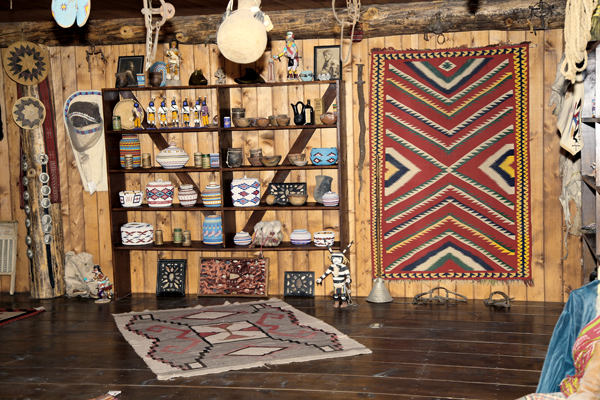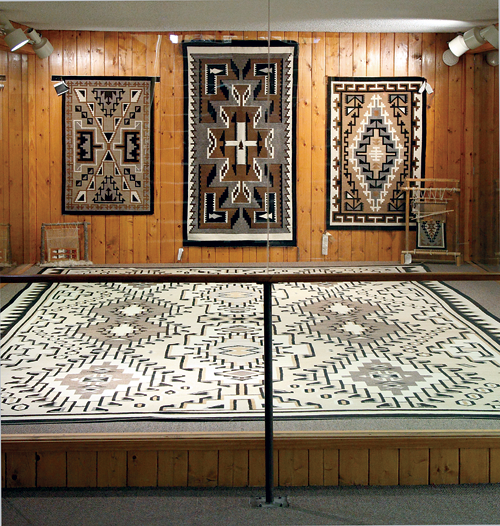Museum

Notah-Dineh's original museum collection was started over 50 years ago, when trading posts served as the commercial and social centers for the reservation. The largest known Two Grey Hills weaving is showcased in the museum. Relics of the Old West in the exhibit include antique bits and bridles, beaded leatherwear, fringed dresses and leggings, and historic firearms. The museum is free to the public.
A Brief History of Trading Posts
The Navajo Indians were a nomadic people that came into the southwest over 500 years ago. They began to trade with the Pueblo Indians that lived in the area before them and with the Spanish that came into the southwest after them until the Southwest Territories became property of the United States in the mid 1800's.Among the Navajo, trading posts began operation in the 1860's when mobility was limited to horse and wagon. Trading posts were supplied with items the Navajo could not produce for themselves like coffee, flour, tools, hardware, etc. Until the end of World War II, government licensed traders brought the outside world to the Navajo.
The traders and trading posts also served as the source for the outside world to buy the items the Navajo produced such as jewelry, wool and the finely woven textiles they became famous for.
By 1900, through encouragement and higher prices paid for quality weavings, the traders and weavers worked together developing certain design characteristics in certain regions of the reservation.
By the 1920's numerous styles of rugs had developed such as Two Grey Hills (New Mexico); Ganado, Teec Nos Pos, and Chinle (Arizona) to name a few. They were named for the trading post in the area where they were developed.
Handwoven Rugs from Two Grey Hills
 The Two Grey Hill's rug became known for its all natural wool colors blended to various shades of tan, grey, brown, black and white. The other distinction was the weavers carded and spun the wool to a fineness rarely found in the other regional styles. The Two Grey Hills style rugs and tapestries are one of the best know, most sought after and expensive patterns, a fact still true today.
The Two Grey Hill's rug became known for its all natural wool colors blended to various shades of tan, grey, brown, black and white. The other distinction was the weavers carded and spun the wool to a fineness rarely found in the other regional styles. The Two Grey Hills style rugs and tapestries are one of the best know, most sought after and expensive patterns, a fact still true today.
One challenge of the Two Grey Hills style of weaving is the making of a rug that is very large in length and width. Due to the extra time and effort to produce the finely woven and intricately designed Two Grey Hills rugs, they are generally smaller in size and more suited to wall use. A 5' by 7' would be considered large.
Creating a Masterpiece
One exception to the rule is a 12' by 18' weaving from the Two Grey Hills area that was started in 1957. Willard Leighton who owned the Two Grey Hills trading post at this time, contracted Rachel Curley to create what he presumed would be the largest Two Grey Hills rug ever woven. Unfortunately, Willard was murdered in 1959 and never lived to see the rug completed.
Between Dubois and Bozeman (Montana) Bob stopped at the Quarter Circle Dude Ranch to show Navajo saddle blankets and rugs to the owner of the ranch. He mentioned that one of his guests was building a beautiful log ranch house and was going to furnish it with Persian rugs. He suggested that Bob might sell him Navajo rugs instead. After spending an extra night and meeting with the gentleman the next day, Bob commented "With the help of the good Lord and some luck, the gentleman ended up with the floors in his new home covered with fine Navajo rugs, including the 12' by 18' Two Grey Hills rug woven by Rachel Curley."
Tracking Down an Old Friend
For the next 30 years Bob often wondered about the large rug and if he would ever see it again. In the late 1980's he received a call from Dan Garland in Sedona, Arizona trying to get some background on a large Two Grey Hills weaving that measured 12' by 18'. Dan had sold the rug to a customer in Santa Barbara, California.
In 1991 Mark Winter, a friend of Bob's who deals in rugs contacted him about a very large Two Grey Hills weaving he had tracked down in California that was for sale. It seems the masterpiece rug was too big for the owner's room. Bob and Mark ventured together to purchase the large Two Grey Hills, the same one Bob had sold 30 years earlier.
The 12' by 18' weaving is considered to be the largest known finely woven and intricately designed Two Grey Hills rug in existence. Rachel Curley lived in the hills between Newcomb and Two Grey Hills, New Mexico trading posts until her death, May 2, 2000. She came from a distinguished family of weavers and was a mature and skilled weaver when she began the 12' by 18' Two Grey Hills.
This magnificent 12' by 18' Two Grey Hills weaving is permanently displayed at Notah-Dineh Trading Company & Museum in Cortez, Colorado.
